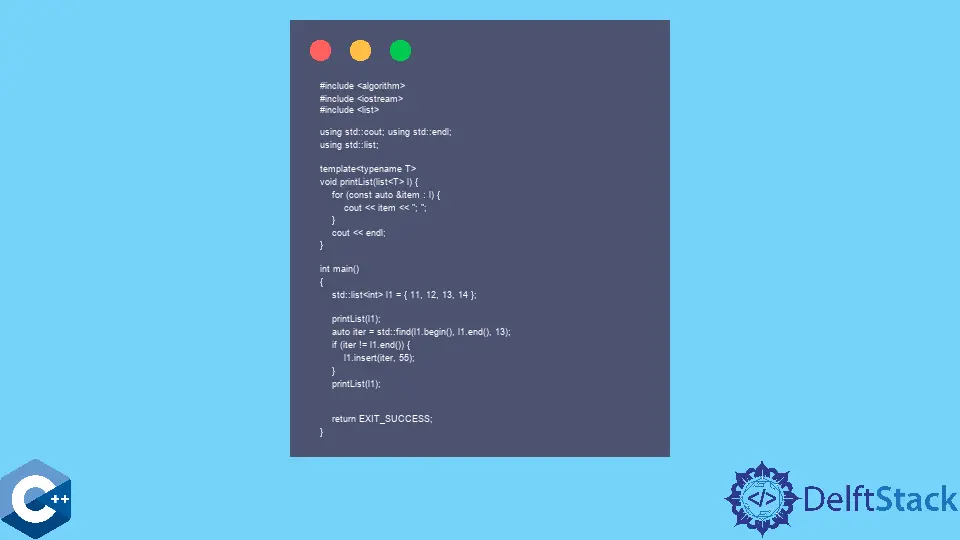在 C++ STL 中使用 STL 列表容器
-
在 C++ 中使用
std::list<T>宣告列表容器物件 -
在 C++ 中使用
insert()函式在列表中的指定位置插入元素 -
在 C++ 中使用
swap()函式交換兩個列表的元素 -
使用
merge()函式將兩個排序列表合併為一個

本文將演示如何在 C++ 中使用 STL list 容器的多種方法。
在 C++ 中使用 std::list<T> 宣告列表容器物件
std::list 容器是標準模板庫的一部分,它實現了一個列表資料結構,該結構提供恆定時間從任何位置插入/刪除元素。它通常被實現為一個雙向連結串列並支援雙向迭代而不是 std::forward_list。不利的一面是,std::list 不具備快速隨機訪問諸如 std::vector 或 std::deque 之類的元素的能力。它只提供兩個常量時間函式,front 和 back 來訪問第一個和最後一個元素。std::list 可以使用給定的資料型別和通用初始化列表符號進行初始化,如以下示例程式碼所示。push_back 和 push_front 方法可用於將元素新增到列表的任一側。
#include <algorithm>
#include <iostream>
#include <list>
using std::cout;
using std::endl;
using std::list;
template <typename T>
void printList(list<T> l) {
for (const auto &item : l) {
cout << item << "; ";
}
cout << endl;
}
int main() {
std::list<int> l1 = {11, 12, 13, 14};
l1.push_front(15);
printList(l1);
l1.push_back(16);
printList(l1);
return EXIT_SUCCESS;
}
輸出:
15; 11; 12; 13; 14;
15; 11; 12; 13; 14; 16;
在 C++ 中使用 insert() 函式在列表中的指定位置插入元素
insert() 成員函式可用於在給定位置新增元素。該函式有多個過載,第一個過載只有兩個引數:迭代器和對物件的引用。給定元素插入到迭代器指向的元素之前。下一個程式碼片段展示瞭如何在列表中查詢特定值,然後在它之前插入所需的元素。
#include <algorithm>
#include <iostream>
#include <list>
using std::cout;
using std::endl;
using std::list;
template <typename T>
void printList(list<T> l) {
for (const auto &item : l) {
cout << item << "; ";
}
cout << endl;
}
int main() {
std::list<int> l1 = {11, 12, 13, 14};
printList(l1);
auto iter = std::find(l1.begin(), l1.end(), 13);
if (iter != l1.end()) {
l1.insert(iter, 55);
}
printList(l1);
return EXIT_SUCCESS;
}
輸出:
11; 12; 13; 14;
11; 12; 55; 13; 14;
在 C++ 中使用 swap() 函式交換兩個列表的元素
std::list 容器的另一個有用的成員函式是 swap(),它將列表物件的元素與作為唯一引數傳遞的另一個列表交換。請注意,此操作不會移動或複製單個元素,並且所有迭代器/引用在函式呼叫後仍然有效。
#include <algorithm>
#include <iostream>
#include <list>
using std::cout;
using std::endl;
using std::list;
template <typename T>
void printList(list<T> l) {
for (const auto &item : l) {
cout << item << "; ";
}
cout << endl;
}
int main() {
std::list<int> l1 = {11, 12, 13, 14};
std::list<int> l2 = {1, 2, 3, 4, 11};
cout << "l2: ";
printList(l2);
l2.swap(l1);
cout << "l2: ";
printList(l2);
return EXIT_SUCCESS;
}
輸出:
l2: 1; 2; 3; 4; 11;
l2: 11; 12; 13; 14;
使用 merge() 函式將兩個排序列表合併為一個
或者,可以使用 merge 成員函式將兩個排序列表的元素合併為一個。請注意,兩個列表都應按升序排序。merge 引用列表物件,其中的元素合併到呼叫者物件中。操作後,作為引數傳遞的列表物件變為空。該函式按升序對結果列表物件的元素進行排序,如以下程式碼示例所示。
#include <algorithm>
#include <iostream>
#include <list>
using std::cout;
using std::endl;
using std::list;
template <typename T>
void printList(list<T> l) {
for (const auto &item : l) {
cout << item << "; ";
}
cout << endl;
}
int main() {
std::list<int> l1 = {8, 10, 2, 4};
std::list<int> l2 = {7, 3, 9, 5, 1};
l2.sort();
l1.sort();
cout << "l2: ";
printList(l2);
l2.merge(l1);
cout << "l2: ";
printList(l2);
return EXIT_SUCCESS;
}
輸出:
l2: 1; 3; 5; 7; 9;
l2: 1; 2; 3; 4; 5; 7; 8; 9; 10;
Founder of DelftStack.com. Jinku has worked in the robotics and automotive industries for over 8 years. He sharpened his coding skills when he needed to do the automatic testing, data collection from remote servers and report creation from the endurance test. He is from an electrical/electronics engineering background but has expanded his interest to embedded electronics, embedded programming and front-/back-end programming.
LinkedIn